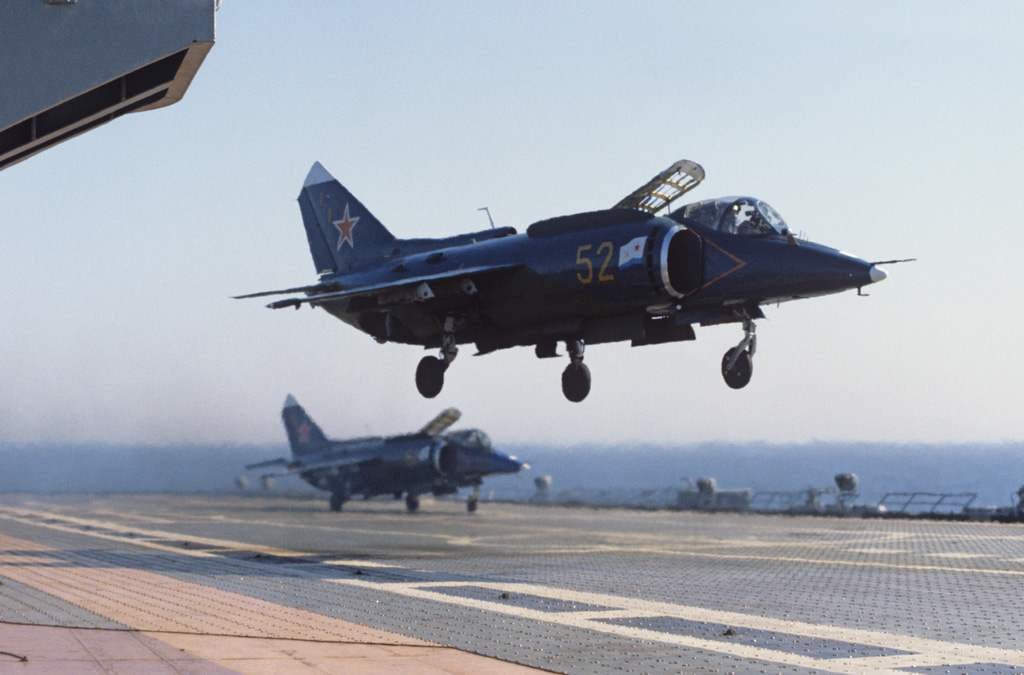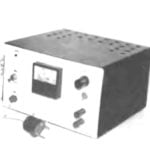 From the first domestic aircraft vertical takeoff and landing (VTOL) Yak-36 did not work fighting vehicle, primarily due to insufficient thrust of the engines. Complicated was and longitudinal balance of the aircraft in hover and transition to horizontal flight (and Vice versa). The emergence of a more powerful turbojet in the near future was not expected. The way out of the situation found the group of designers headed by S. G. Mordovin has.
From the first domestic aircraft vertical takeoff and landing (VTOL) Yak-36 did not work fighting vehicle, primarily due to insufficient thrust of the engines. Complicated was and longitudinal balance of the aircraft in hover and transition to horizontal flight (and Vice versa). The emergence of a more powerful turbojet in the near future was not expected. The way out of the situation found the group of designers headed by S. G. Mordovin has.
Despite the skeptics, they went back to the previously considered scheme and started to work on the car with the hybrid powertrain, the motors: lifting and propulsion (PMD) with rotating nozzles and a pair of lifting (PD). But here the opinions of the designers differed. Some of them insisted on single-engine scheme.
After the meeting of the scientific and technical Council of the Ministry, in December 1967 there was a government decree on the establishment of a light attack aircraft with vertical takeoff and landing Yak-З6М with polyammonium TRD Р27В-300 and two lift РД36-35. The car was intended to combat surface ships, support the landing and escort a variety of vessels. The document also provided for the establishment of his combat training variant, and the fighter.
Studies conducted in OKB A. S. Yakovlev showed that in any case the advantage of the combined power plant before the “one” is its energy flexibility.
Since we are talking about the power plant, I would like to note one feature. Lifting and propulsion turbojet engines were run in the traditional starter, and lifting spun by air, selected from the compressor. Then the air flow from the compressor switched on jet rudders. Thus the take-off phase was given about 20 seconds otherwise developed recirculation of the mixture of air and gas jets turbojet engine around the car.



Carrier-based attack aircraft Yak-38M:
1 — rod LDPE-18G; 2 — antenna of the defendant IFF systems SRO-2M; 3 — visor lights; 4 — movable part of the lamp; 5 — ejection seat K-36ВМ; 6 — top panel lift engines (PD) РД38; 7 — upper gastralia ribs; 8 — cover of the hatch of a mouth of a centralized fuelling; 9 — launcher APU-60-1МД; 10 — air intake blower compartment PMD Р28В-300; 11 — static electricity discharger; 12 drive information “Edge-VM”; 13 — rotary nozzles, nozzle PMD Р28В-300 in the position of vertical take-off; 14 — beam holder arms BDZ-60-23Ф1; 15 — brake wheel КТ61/3 660×200 mm; 16 — fold lower PD РД38; 17 — landing light; 18 — fold niche of the front landing gear; 19 — a non-braking wheel-To-298 600×150 mm; 20 — trimmer of the rudder; 21 — the rudder; 22 — ending-the Radome VHF-radio Р860-1; 23 — slot antenna system for short-range navigation RSBN-36; 24 — Kiel; 25 — grate airflow to the fairing; 26 — air inlet cooling mechanism of rotation of the nozzles nozzles GM-40; 27 — omnidirectional antenna, automatic radio compass, ark-15; 28 — valve fuel intake PMD; 29 — emergency PVD; 30 — reception antenna RSBN-36; 31 — button pressurization; 32 — additional gastralia ribs; 33 — main gastroretentive ribs; the 34 — rotary nozzles, nozzle PMD Р28В-300 in a marching position; 35 — antenna of the defendant IFF systems; 36 — station antenna warning radar illumination; 37 — the steering wheel height; 38 — trimmer rudder, 39 — stabilizer; 40 — technological connector of the fuselage frame No. 29; 41 — antenna of the defendant IFF systems; 42 — wing jet drive; 43 — Board air navigation light; 44 — fold niches main landing gear; 45 — radiotransparent Radome system “the siren-1”; 46 — the bow jet steering wheel; 47 — R-60 class “air — air”; 48 — uniform and gun containers UPK-23-250; 49 — fitting; 50 — fold compartment drogue PT-36; 51 — jet tail wheel; 52—sensor indicator fragile attack; 53—the fixed part of the wing; 54—fold part of the wing; 55 — Aileron; 56 trimmer Aileron; 57 — retractable flaps; 58 — hinge joints of the folding console; 59 — antenna ark-15; 60 — by-pass valves PD РД38
From the date of the decision before the construction of the first prototype took a little over two years. In may 1970 the Yak-З6М (car No. 05) was transferred to the airport LII for studies on the cable crane. The appearance of the attack had nothing to do with the predecessor, and the only thing they have in common is the name. The new layout is identified and a new scheme for chassis, which became tri-prop with a nose wheel.
In September, the test pilot V. G. Mukhin for the first time, she took a car from the ground, hovering a few feet from her. Then followed taxiing, approach and, finally, on 2 December Mukhin, taking off on an aircraft built by the time the second car, made a circle over the airfield. Almost a year preparing for the flight in full profile, held on 21 February 1971, This historic flight, which heralded the birth of the USSR in the first combat VTOL, had a chance to perform pilot-test pilot OKB of M. S. Deksbah. By the time the factory tests involved three prototype of the future Yak-38.
Six months later, the Deksbah first landed a plane on the deck of the cruiser “Moscow”, located in the open sea near the Kerch-Feodosia naval base. Four days later he circled the ship and landed on its deck. Factory test Yak-36M was completed in April 1972 and Then the aircraft was transferred to NII VVS. The lead pilot from the air force Institute were V. Khomyakov, then testing connected V. Vasenkov, N. Shlykov and G. Parshin.
Officially, the state tests of the Yak-З6М held intermittently for various reasons, ended in October 1974, but they lasted until the fall of 1975 and ended on avianese the cruiser “Kiev”. But this does not mean that all issues have been resolved, and for many years the pilots of the NII VVS was lifted in the sky “yaki”, checking certain improvements.
In 1974, simultaneously with the completion of the tests in NII VVS, the Institute has recommended to allow the Yak-36M for use in combat units and to conduct state tests of the aircraft carrier.
In August 1977 the Yak-36M was adopted under the designation Yak-38, but four years before serial production of the “Yak” has become the Saratov aviation plant.
First serial Yak-36M Saratov aircraft factory was built in the autumn of 1974 and 30 September machine made its first flight. In the same year, the customer handed over three cars.
During series production of the Yak-38 entered the two-wire circuit control valves bleed air from the compressor lift-cruise engine and control the rotation of its nozzle and a number of other modifications, significantly improved the reliability of the machine. Increased track chassis and improved characteristics of stability and controllability.
First serial Yak-З6М manned lift engines РД36-35ВФ, ejection seats QW-1M and different weapons. For example, they could see the optical sight ASP-17 fighter-bomber su-17 and ASP-PF-21 with the MiG-21.
In April 1975, lost first car. In that day the Deksbah, ablative serial Yak-З6М before landing did not notice that the game does not start one of the lift engines.
The main characteristics of the VTOL Yak-38 engines Р27В-300 and РД36-35ФВР

Exactly eleven months later there was another accident. This time the test pilot NII VVS Khomyakov because of a defect in the wiring system triggered automatic ejection SK-GP. The aircraft, “manned” SAU-36 automatic mode, up to a height of about 10,000 m and after generating fuel fell to the ground. All this was followed by the appropriate revision.
The first aircraft carrier for the Yak-38 was the “Kiev” with a displacement of 41 400 tonnes, transferred to the Navy in 1975, and next year foreigners for the first time recorded the “Yak” on the deck. Two years later I entered into a system “Minsk”, and in 1979 — “Novorossiysk”. Each of these ships were up to 36 aircraft and helicopters Ka-27. In 1987, the Navy included the aircraft carrier “Admiral Gorshkov” 44 with a displacement of 500 tons, able except the Yak-38 to bear and developed a supersonic VTOL Yak-41. The fate of these ships otherwise how tragic will not name, because after the collapse of the Soviet Union, they were not needed in the new Russia.
Operation of the Yak-38 in different climatic zones has revealed significant shortcomings of the car. Thus, in conditions of tropical heat and high humidity did not start the lifting engines, and had to urgently be equipped with special devices using supplemental oxygen. Heavily fell the thrust of the main engines and vertical take-off became possible only with incomplete refuelling. During takeoff with weapons fuel is sometimes enough just to fly around the ship.
For the successful operation of the machine and solve problems facing the Navy, it was necessary first of all to increase the thrust of the power plant. The problem is not simple, and at first was only to modify the hoist motor option РД36-35ФВР, increasing the thrust up to 3050 kgs. Planned water injection to increase thrust in a hot climate, but these ideas never implemented.
Apparently, at the same time on the aircraft side of the intake lifting turbojet engines appeared longitudinal ribs that protected them from their own exhaust on takeoff.
Another way of expanding the combat capabilities of the attack aircraft was a short run. Tested it first in the fall of 1978 test pilot LII O. G. Kononenko land at the airport. Almost two years perfected this technique, and only in the summer of 1980 and had to try it on the ship. However, on September 8 during takeoff from aircraft carrier Minsk, located in the Indian ocean, “Yak” came from the deck of the ship and fell into the water. It was the first domestic VTOL crash that claimed the life of Kononenko. Followed by another research and refining, prolonged for more than two years.
NATO responded to the emergence of the Yak-38, giving it the name of the Forger, which translated to English means “Blacksmith”.
In those same years, to expand the tactical capabilities of VTOL explored the possibility of basing on a specially equipped automobile trailers and the civil courts. In the latter case used ship “Agostinho Neto” and container ship “Nikolai Cherkasov”.
From April to may 1980, the Yak-38 were “trained” in Afghanistan. This organized experienced mixed squadron (commander test pilot NII VVS V. V. Vasenkov), which included four Yak-38. Flights from high elevation airfield Shindand in real combat conditions once again proved insufficient, even for takeoff with short takeoff, the thrust of the power plant.
During the test flights made one significant revision: turned the nozzle of the second lifting motor 15 degrees ago. This helped to improve take-off from high elevation airport.
The first modification of the VTOL was double training Yak-36U (product VMC) with cabins of the student and the instructor, causing the fuselage lengthened by 1.39 m. flight tests of the Factory the training started in March 1973 and after completion of both phases of the joint state tests in September 1977 it was launched into serial production. In November of the following year the aircraft was accepted into service under the designation Yak-38U.

The Yak-38
A feature of the aircraft was a system of salvation of the crew with chairs TO-36V with controllable pitch nozzle of a jet engine and a forced ejection from breeding trajectories seats of the instructor and the student that have significantly reduced the number of accidents. However, the total losses of the Yak-38 during their testing and exploitation is small (40 vehicles), lower than that of “the Harrier”. While the bailout was 32, including 19 as a result of triggering the automatic system. One of them became foreign seamen in the summer of 1985 during a training exercise in the Norwegian sea, when the pilot of the Yak-38 taking off with takr “Kiev”, had to eject. The last of capitulatory accounted for by test pilot LII V. V. Zabolotsky in the summer of 1992 in preparation for the air show in Zhukovsky near Moscow.
In 1980, the OKB as Yakovlev has prepared a decision on a long-term (MEA, air force, and Navy) program of increasing the combat capabilities of Yak-38. From the whole complex of the planned works implemented taking off from the deck with the runway, landing “slippage” and modernization of the aircraft, which included the installation of more powerful lifting and sustainer engine Р28В-300 maximum horizontal thrust of 7100 kg and lifting engines РД38 thrust 3250 kgs. Upgraded Yak-38M was accepted into service in 1985, this improvement of the Yak-38 was stopped for fear of damaging the program supersonic VTOL Yak-41. At the same time US and England continue to improve, “Harrier”, which at the initial stage of testing barely raised himself, not to mention the combat load.
In conclusion, it should be noted that of the more than 50 projects only VTOL “Harrier” and Yak-38 was brought to serial production and operation. In the USSR, “yaki” for a long time removed from service. As for the “Harrier”, in addition to England and the USA they are used in Spain, Italy and India.
N. In. YAKUBOVICH



